It’s common for investors to feel confused when major financial news channels report a market index, like the S&P 500, hitting a record high, yet their individual portfolio performance is mixed. This scenario of divergence, where the index soars but many individual stocks lag, is a classic market problem.
Fortunately, there’s a powerful tool designed to cut through this noise: the Advance Decline Line (A/D Line). It functions as an honest, behind-the-scenes “health report” for the entire stock market, revealing the true level of participation beneath the index’s price.
This guide provides a perfect starting point for any beginner, breaking down this professional-grade tool into simple, understandable steps. Readers will move from basic definitions to deep insights, gaining the confidence needed to analyze the market effectively.
Key Takeaways
- The Advance Decline Line (A/D Line) tracks the net number of advancing vs. declining stocks to gauge the market’s internal health.
- If the A/D Line rises with the market index (e.g., S&P 500), the rally is healthy and sustainable.
- Divergence (A/D fails to match the index’s new extreme) is a powerful early warning of trend exhaustion.
- It cuts through price distortion caused by a few large stocks, revealing true broad market participation.
- Analyze on daily charts as a macro-strategic tool, confirming its signals with price action.
1. What is the advance decline line?
The Advance Decline Line (A/D Line) is a specialized technical indicator used to measure a concept called market breadth.
The A/D Line concept was first calculated and analyzed in 1926 by economist and market analyst Colonel Leonard Ayres. Subsequently, the concept was popularized by James Hughes and began to be published by financial journals like Barron’s in the 1930s, gaining significant prominence in the 1960s.
At its core, the A/D Line tracks the cumulative total of advancing stocks minus declining stocks each day. Its primary purpose is to provide a health report for the entire market, revealing the true level of participation beneath the surface price.
- Trend Confirmation: It is used to confirm the trend of major indices (like the S&P 500).
- Health Signal: A rising A/D line suggests broad market strength; a falling A/D line signals underlying weakness.
- Core Principle: It shows how many individual stocks are genuinely driving the trend, rather than just a few mega-cap stocks.
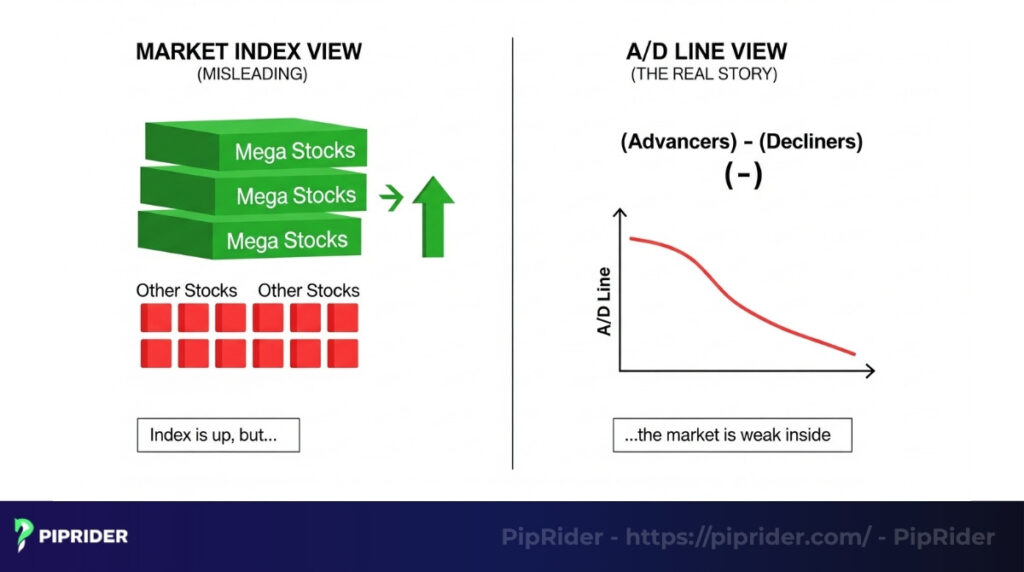
2. Why the A/D Line is Crucial for New Traders
The A/D Line offers a unique perspective that price action alone simply cannot, making it especially vital for beginners. It helps new traders grasp what’s truly happening behind price movements by providing an objective, independent view.
The A/D Line’s importance stands out in two key areas:
- A Filter Against Distortion: It provides a crucial filter against the misleading performance of a few dominant, mega-cap stocks. By measuring the average stock, it prevents traders from being lured into buying a rally that is internally weak.
- The Early Warning System: The A/D Line is one of the most dependable early warning systems in technical analysis. It helps traders spot market weakness or strength long before it becomes obvious in the price itself, providing crucial time to adjust strategy or prepare for a potential reversal.
3. What the A/D line is actually telling you

In a single glance, the A/D line offers a rapid assessment of the market’s overall condition. It answers three critical questions that reveal the true structural integrity of the trend:
- Is the Trend Healthy and Sustainable? (Confirmation): When the A/D line moves in sync with the index (e.g., both rising), it sends a clear message that the trend is healthy and supported by broad participation from a wide range of companies.
- Is the Trend Running Out of Steam? (Divergence): This is where divergence occurs. When the index makes a new peak while the A/D line refuses to follow, it is a significant alert. It tells you the foundation of the rally is cracking, and the risk of a reversal is growing significantly.
- Who is Really in Charge? (Market Breadth): The A/D line reveals the true character of a market move. It helps you distinguish between a genuine, broad-based rally and a fragile advance driven by only a handful of mega-cap stocks. Healthy markets have wide participation, and this is the tool that measures it.
Understanding these three signals is the key to unlocking the full potential of this indicator. Now, let’s look at the simple mechanics behind how it’s built.
4. How to calculate the A/D Line?
The Accumulation/Distribution (A/D) Line’s formula might look technical, but its core concept is quite simple. Think of it as a running tally of the market’s daily health.
The A/D Line is calculated cumulatively in two straightforward steps:
- Daily “Net Advances”: Each day, the market determines the “Net Advances.” This is simply the number of stocks that went up minus the number of stocks that went down.
- Cumulative Sum: This daily “Net Advances” figure is then added to the previous day’s total A/D Line value.
So, the formula is:
A/D Line = Yesterday’s A/D Line Value + Today’s Net Advances
Traders do not need to manually calculate the A/D Line, as charting software performs the math instantly. The essential task for the analyst is to focus entirely on reading the story the resulting line tells. This is a tool of interpretation, not calculation.
5. How to apply the Advance Decline Line in actual market analysis
This is where we turn knowledge into actionable strategy. Let’s explore the two powerful ways to use the A/D line, complete with real-world scenarios.
5.1. Confirming the trend
This is the most straightforward use and a great way to build your confidence. You are simply checking if the market’s internals agree with its external appearance.
- In a healthy bull market: The S&P 500 is making a series of new highs. You look at your A/D line chart, and it’s doing the exact same thing, marching right up alongside the index. This confirmation feels like a green light. It tells you the rally is broad and has fuel in the tank.
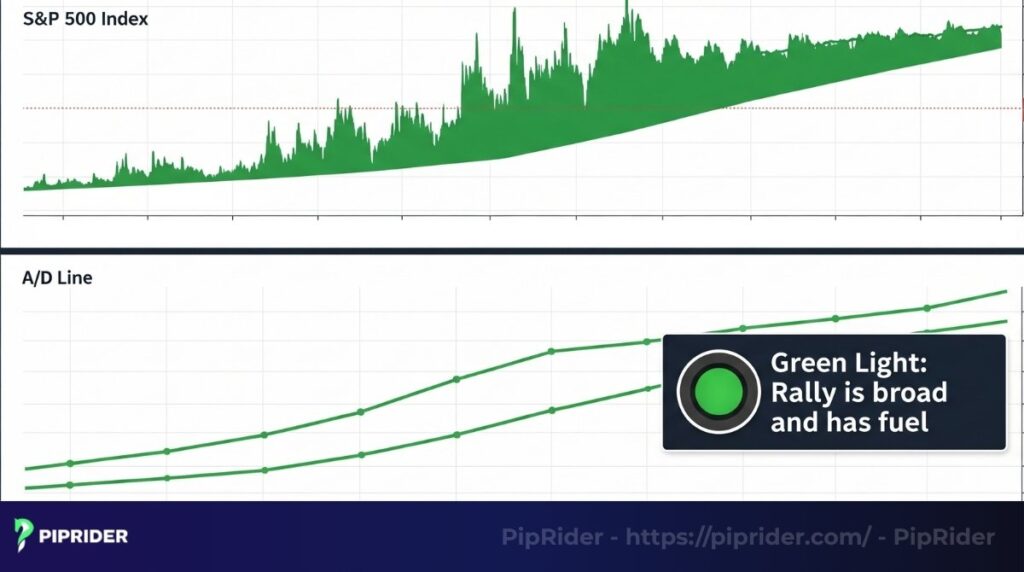
- In a real bear market: The index is clearly trending down, making lower lows. The A/D line is also tumbling downwards. This confirms that the selling pressure is widespread and not just isolated to a few sectors.
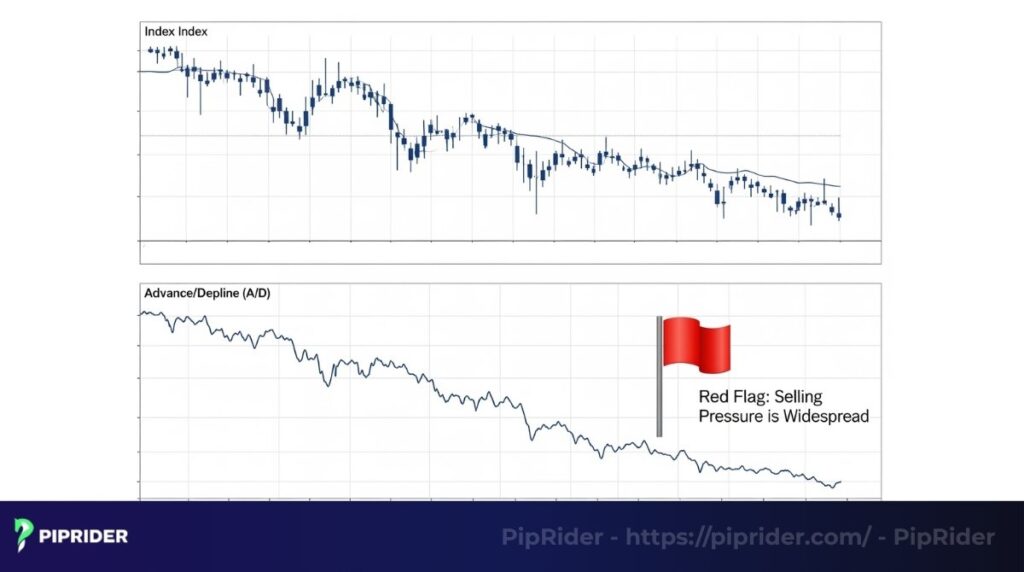
5.2. Spotting divergences
Divergence is when the price and the indicator tell you two different stories. This is where the A/D line earns its reputation as a legendary market tool.
5.2.1. Bearish divergence
Imagine this common scenario: The bull market has been running for months. Market sentiment is overwhelmingly positive, and the S&P 500 has just climbed to another all-time peak.
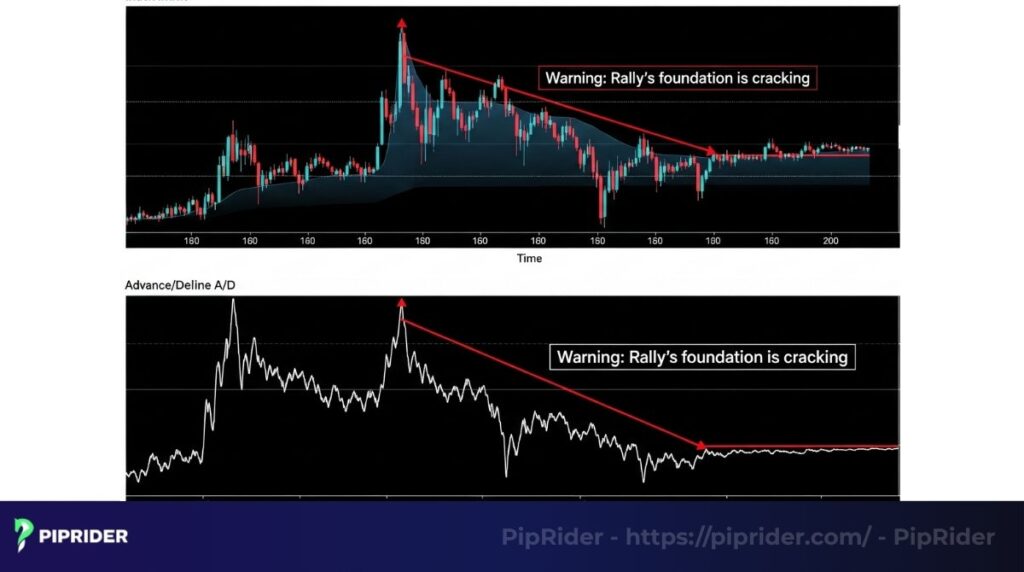
But you pull up the advance decline line. You notice a striking disagreement: the index has pushed to a new record high, but the A/D line has refused to follow, charting a lower high instead.
- What this is telling you: This visual conflict is a classic signal of deep, internal weakness. While a few big-name stocks are doing the heavy lifting to drag the index higher, the average stock is no longer participating. This represents a textbook example of internal decay, signaling that the rally’s structural integrity is becoming compromised.
5.2.2. Bullish divergence
Now, picture the opposite: The market has been in a painful downtrend. Fear is everywhere, headlines are terrifying, and the index just plunged to a new low. Panic selling is in the air.
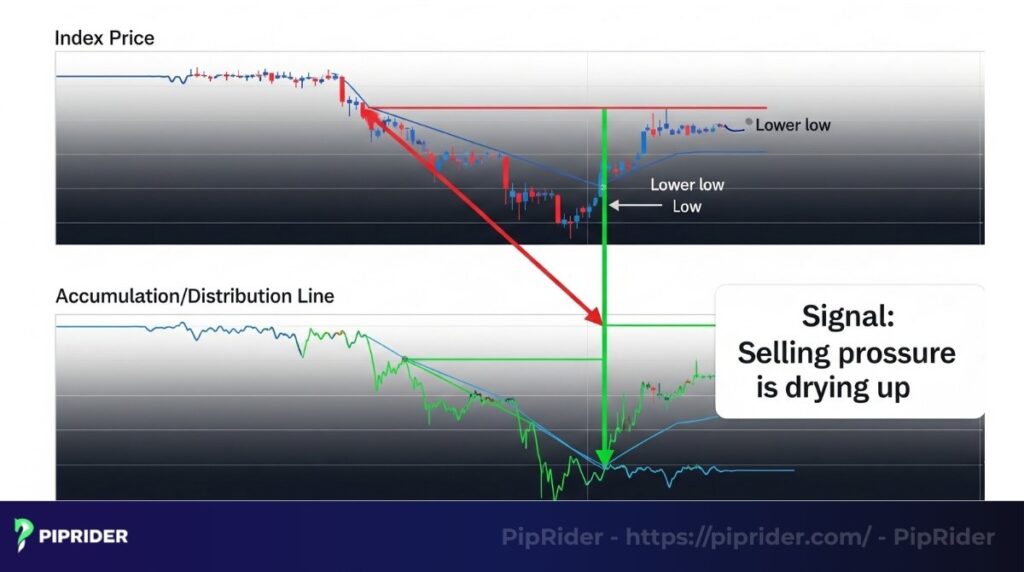
But the A/D line is telling a different story. As the index plunges to a new, fear-inducing low, the A/D line does something different: it carves out a higher low than its previous one.
- What this means: Even as the index price falls, the selling pressure is drying up. Fewer stocks are making new lows with the index. This is a subtle sign of “quiet accumulation,” where smart money begins to step in and buy beaten-down stocks. It suggests the worst of the selling may be over, and a base is being built for a potential new uptrend.
Read more:
Mastering the Accumulative Swing Index for better trades
Unlock trades with Accumulation Distribution Indicator (A/D)
6. The A/D Line’s Limitations
A professional trader knows not only how to apply a tool but also precisely when that tool might fail. Understanding the Advance Decline Line’s weaknesses is just as critical as knowing its strengths for managing risk effectively.
6.1. It’s a Warning Light, Not a Timer
The most crucial lesson regarding the A/D Line is that divergence is a signal that market conditions are right for a reversal, not an exact time to execute the trade. Traders have historically observed bearish divergences build for months while the broader market indexes continued to grind higher. Traders who jump the gun and short the market based on divergence alone often face being stopped out prematurely.
Practical Takeaway: Treat a divergence as a signal to change market posture, not position immediately. If a bearish divergence appears, traders should stop aggressively buying, begin taking partial profits on existing long trades, and tighten stop-losses. However, they should generally wait for price action itself to confirm the turn before initiating a large counter-trend position.
6.2. It Demands Confirmation
A divergence signal in isolation is merely an observation. An actionable trading signal requires confluence of multiple, non-correlated factors pointing to the same conclusion.
Practical Takeaway: A common mistake is acting solely on the A/D Line. Instead, view the divergence as the first piece of evidence that requires validation. Traders should seek confirmation from price action itself:
- Has a key upward trendline been broken?
- Has the index formed a classic reversal pattern, like a Head-and-Shoulders top?
- Did the price make a confirmed close beneath a significant moving average, such as the 50-day?
The setup only becomes a high-probability trade when the price action validates the A/D Line’s internal warning.
7. Advanced Analysis: Creating a confluence of signals
The A/D line’s analytical power is amplified when it’s used as a core component within a broader analytical framework. Let’s move beyond just pairing it with one tool and see how to build a complete analytical process.
7.1. Combining with moving averages for context
The job of a moving average is to define the primary direction of the market’s momentum. The A/D line’s role, in contrast, is to measure the underlying vitality of that same trend. Using them together provides a powerful macro view.
- The Pro-level setup:
- The context: With the S&P 500 holding above its 200-day moving average, the long-term trend is clearly established as bullish.
- The warning: You spot a bearish divergence on the A/D line over several weeks. This tells you the healthy bull market is now showing internal signs of sickness.
- The trigger: Your action signal is a confirmed price break and close beneath the 50-day moving average. This is your confirmation that the weakness the A/D line hinted at is now translating into actual price momentum to the downside. This combination of signals is far more reliable than any of them alone.
7.2. Using momentum oscillators (RSI & MACD) for better timing
If the A/D line is your strategist, then momentum oscillators are your field commanders. They help you pinpoint the moment of execution.
- The Pro-level setup:
- The strategic warning (A/D Line): You’ve identified a clear bearish divergence in market breadth.
- The momentum confirmation (RSI): You look at the RSI. You notice that as the price made its final high, the RSI was also in a bearish divergence (it failed to make a new high) and was falling from overbought territory (above 70). This tells you short-term momentum is also dying.
- The execution signal (MACD): With both breadth and momentum weakening, you wait for one final trigger: a bearish MACD crossover, where the MACD line crosses below its signal line. This often provides a precise entry point for a trade.
By layering these tools, you build a robust case for a market turn instead of relying on a single, isolated clue.
8. Frequently asked questions about advance decline line
9. Conclusion: A new way to see the market
The advance decline line is more than just a technical tool; it’s a fundamental shift in perspective. It trains you to look beyond the distracting headlines and focus on the true, internal health of the market.
By mastering the simple arts of trend confirmation and divergence, concepts that might have seemed complex at first, any trader, including a dedicated beginner, can learn to spot major market turning points with greater clarity. By incorporating the A/D line into your routine, you stop just following price and start understanding the powerful story the market is truly telling.
Don’t forget to follow piprider.com to learn more useful knowledge about technical indicators, ranging from beginner fundamentals to advanced strategies.











